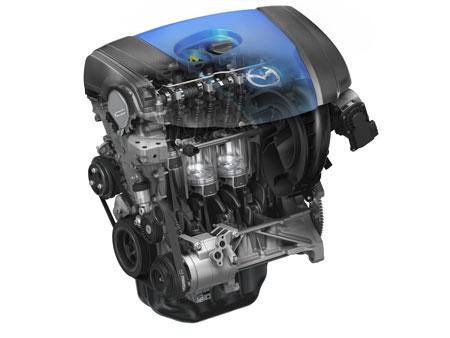| Mazda has turned internal combustion engine theory on its head with the announcement of a new four-cylinder engine family. In an age when the buzz-words for petrol units are ‘small-capacity’ and ‘forced induction’, Mazda’s SkyActiv-G (for gasoline) is sticking with natural aspiration and comparatively large capacity. It has also broken new ground with an unheard-of compression ratio of 14:1. When hotshots like the BMW M3 top out at 12:1, that’s a trick calling for huge engineering smarts…and equally huge cojones, for the prize for second place is self-destructing powerplants as the dreaded ‘knock’ cuts loose. The other side of the coin is equally ground-breaking, for the matching SkyActiv-D (diesel) range has the same 14:1 compression ratio as its petrol siblings. Conventional wisdom has that oil-burners need at least 17:1, primarily because lower ratios lead to poor cold-start performance and misfiring during warm-up. On the other hand, lower compression is a very good thing, for it dramatically reduces the formation of NOx (oxides of nitrogen) and soot in a diesel’s exhaust, and after a decade-long investigation into the fundamentals of internal combustion Mazda believes it has cracked the conundrum. But wait, there’s more. Future Mazda petrol engines are likely to boast compression ratios as high as 18:1, says Susumu Niinai, program manager for the company’s powertrain development division. Speaking at a recent Mazda technology forum at Sandown Park in Melbourne, Niinai-san said his company was working on engines that use HCCI (homogenous charge compression ignition) for undreamt-of levels of efficiency. Asked how far in the future production examples using this principle would be, his answer was succinct: “Very far.” But, he added, Mazda was confident they would be built. Back in the present, the SkyActiv powerplants claim deeply impressive credentials. For the two-litre petrol version these include around 15 percent better fuel economy than the current MZR 2.0 (making the engine competitive with leading diesels), plus 15 percent better low- and mid-range torque. For the diesel the figures are equally as impressive – 20 percent better fuel economy than Mazda’s current 2.2-litre diesel, petrol-rivalling peak revs of 5200rpm, and the ability to meet all the latest emissions standards (Euro 6, USA Tier 2 Bin 5, and Japan’s forthcoming PNLTE regulations) without expensive NOx after-treatment systems like SCR (selective catalytic reduction) or LNT (lean NOx traps). Backgrounding the breakthrough designs, Kiyoshi Fujiwara, Mazda’s executive officer in charge of product planning and power-train development, explained they stem from the decision made by the board of the company 10-12 years ago to boost the funds for pure research. “As a small company, we seldom before have had the money to carry out this sort of work,” he said. “With the help of an advanced single-cylinder test engine that allowed high-speed photography of the combustion process, our engineers were able to extend the theoretical boundaries.” The recent installation of a four-cylinder test engine will allow the research to reach even further, he added. A key anti-knock technology in the SkyActiv-G is the reduction in the cylinder of residual gases from the previous cycle. With a conventional, short four-into-one exhaust header, high-pressure resonant waves from other cylinders can push hot exhaust gases back into a cylinder as it finishes its exhaust stroke and begins its intake cycle and thus elevate cylinder temperatures in the moments before ignition, leading to knocking. Mazda’s fix was to adopt a long, four-into-two-into-one system, in which the high-pressure waves have a much different resonance. On the down side, this approach puts the exhaust catalyser further away from the cylinders, lowering exhaust temperature in that area and thus delaying catalyser light-up. The answer was a neat bit of technical tight-rope walking – raising the temperature of the exhaust (but not the cylinder overall) by concentrating the direct fuel injection into a bowl set in the centre of the piston crown. This has several benefits: because of the pocket of rich mixture concentrated around the spark plug tip, ignition is sure and combustion quick and thorough even at overall lean fuel/air ratios; the concentrated burn means lower heat losses through the piston; and unlike high-compression designs with domed piston tops, the spark plug tip is set further from the piston, promoting a quicker and more even combustion. Reduced weight and friction in all components have also contributed to the SykActiv-G’s efficiency gains. For the diesel, the equation goes thus: high compression ratio equals high temperature and pressure at top dead centre, equals ignition beginning before the injected fuel has mixed properly with the air, equals the formation of NOx and soot. One fix is to delay injection until the piston has passed TDC, but this harms fuel economy. |
A lower compression ratio means a later start to ignition, and so a more thorough mixing of fuel and air. The time difference can be less than a thousandth of a second, but it’s significant. The ability to inject fuel earlier in the stroke also means a lower-compression engine is putting work into the piston for longer, so improving efficiency. |






